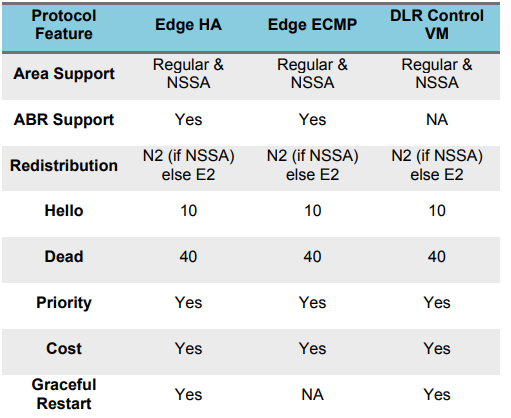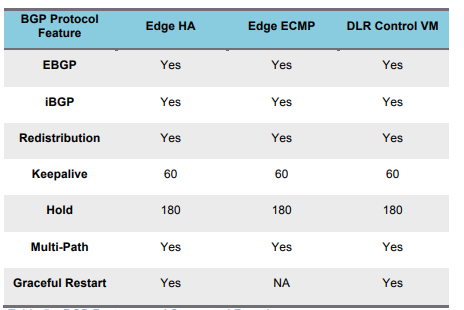1. HSRP is a layer 2 technology meaning that it use the VIP mac address for forwarding in layer 2 domain, therefore instead of HSRP, I think I should use layer 3 protocol such as BGP and OSPF for redundancy. I am going to create a separated vlan for each core (vlan 4 for left switch / vlan 5 for right switch). HSRP does not know about both vlan 4 and 5. For example, left core does not have vlan 5 while right core does not have vlan 4. Am I correct so far?
You certainly need a routing protocol for Edge peering with Cisco 4503 . Assuming you have DLR use case as well, its better to simply End-End routing either with OSPF or BGP ,but better don't mix and match by having few OSPF , few bgp kind of design .Also you have mentioned VLAN 4 and 5 is not part of HSRP. That is fine and i don't find any challenges with that approach But one of the requirement is Edge and Core redundancy based on failure scenarios. So at max one device is required (1 edge and 1 core) for traffic to flow flawlessly. Below matrix is for OSPF & BGP and be aware of what features are available in HA&ECMP modes. In your case you are looking for Edge-HA .


https://communities.vmware.com/servlet/JiveServlet/previewBody/27683-102-10-41631/NSX%20Reference%20Design%20Version%203… page : 59
Please go through the routing section once, since they are much more points that you should consider or be aware of.
2. Please clarify if these statements are correct (or guide me a best practice)
In terms of the perspective of left side edge (L-Edge), L-Edge makes OSPF neighbors with L-Core and R-Edge by using vlan 4.
In terms of the perspective of right side edge (R-Edge), R-Edge makes OPSF neighbors with R-Core and L-Edge by using vlan 5.
I'm bit confused with above statement/requirement . Are you in need of having routes learned by each Edge to be distributed to core and bring them under a single area ? If you are going with OSPF approach you area design matters more than VLAN-ID's
3. What is the best practice here in edge uplinks?
Should L-Edge only connect L-core switch by using vlan 4 while R-Edge only connects R-core switch by using vlan 5? or my below topology is fine? Basically I like to have a good redundancy when one of cores is down (or when one of Edges is down).
So you are in need of sending same routes via both the edges via different upstream VLANS and expecting redundancy ? ECMP is better approach design here and you can limit the ECMP edges to 2 in number . But no state-full services at edges in that case.
4. Are vlan 4 and vlan 5 VXLANs, so I should make MTU size 1600?
This depends upon on the uplinks selected for VTEP configurations. Assuming you have dedicated uplinks for VTEP connectivity , MTU change is required for entire VTEP path across single/multi subnet based on VTEP design approach. The MTU for the VDS uplinks of the ESXi hosts performing VXLAN encapsulation is automatically increased when preparing the host for VXLAN